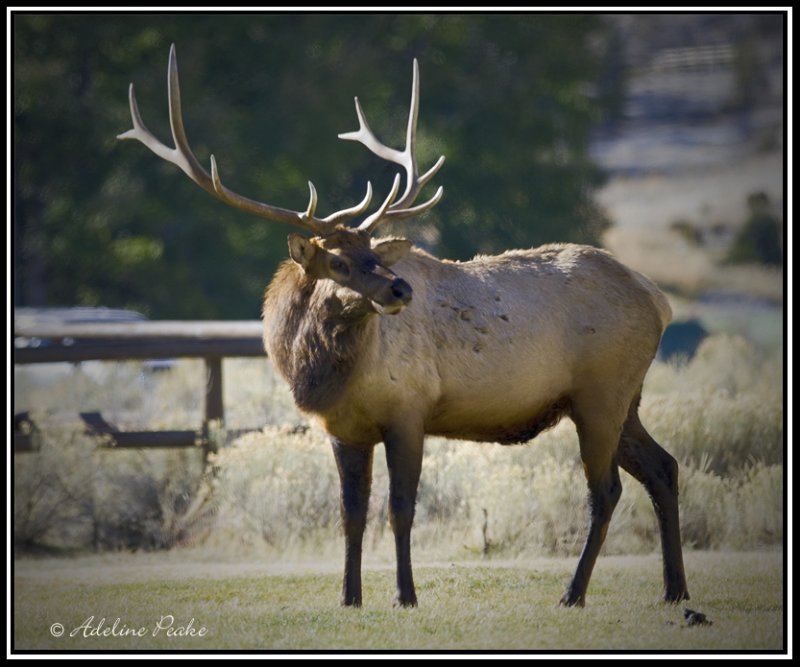
This food is stored in a stomach called the “rumen.” From there, the food is regurgitated, then re-chewed before being swallowed again, entering a second stomach where digestion begins. They initially chew their food just enough to swallow it. Like deer and moose, elk are ruminants.During fall and winter, elk continue to eat grasses when these are available and not covered by deep snow.In fall, elk increasingly become browsers, feeding on sprouts and branches of shrubs and trees, including conifers as a last resort when snow covers other plants.In spring and summer, when food is plentiful, elk are mainly grazers-eating grasses, sedges, and a variety of flowering plants.Elk require large amounts of food because of their body size and herding tendencies.The antlers of Rocky Mountain elk are typically more slender, have longer tines, and are less palmated than Roosevelt elk antlers. Rocky Mountain elk are slightly lighter in color than Roosevelt elk, and their average size is slightly smaller. Many Rocky Mountain elk populations currently in Washington stem from elk transplanted from Yellowstone National Park in the early 1900's. They now overlap with Roosevelt elk in the southern Cascade Mountains and adjacent areas. Rocky Mountain elk ( Cervus canadensis nelsoni) are found primarily in the mountain ranges and shrubsteppe of eastern Washington, with small herds being established or reestablished throughout the Pacific Northwest. Olympic National Park and surrounding forests host the largest number of Roosevelt elk living anywhere - about 5,000. Roosevelt elk ( Cervus canadensis roosevelti) are found in the coastal ranges of the Olympic Peninsula, southwest Washington, and the western slopes of the Cascade Range including Western Washington river valleys. Geographic rangeĮlk are found throughout Washington, with two seperate subspecies primarily occupying opposite sides of the Cascade Crest. With thick bodies, short tails, and long legs, adult elk stand 4.5 to 5 feet high at the shoulder. New antler growth begins soon after shedding.Īdult elk weigh 600 to 800 pounds, and adult cows typically weigh 400 to 500 pounds. Elk shed their antlers beginning in late February for the largest males, extending to late April and even early May for younger ones. In late summer the velvet dries and falls off to reveal the bonelike structure of the fully-grown antlers.
#ADULT MALE ELK SKIN#
Like other members of the deer family, the antlers of bull elk grow during spring and summer beneath a hairy skin covering known as velvet. In winter, a dark brown, shaggy mane hangs from the neck to the chest. Monofilament recovery and recycling programĮlk range in color from light brown in winter to reddish tan in summer, and have characteristic buff-colored rumps.Despite its ability to stand, newborn elk will remain motionless, lying in thick brush for the first week of its life. The lifespan of an elk averages 10 to 13 years in the wild but can exceed 20 years in captivity.īaby elk are well developed, and can stand on their feet 20 minutes after birth. Most mating takes place during the fall months, resulting in summer births. Gestation generally lasts between 240 and 262 days and results in a single offspring.
:max_bytes(150000):strip_icc()/bull-elk-bugling-during-rut-season-in-yellowstone-national-park-174753024-74c8156f507f48289b100f0f2969fc17.jpg)
During the winter, they may consume tree bark when grass is unavailable.īoth males and females are sexually mature at 16 months, although males do not usually mate until they are at least 2 years old and able to compete with fully mature males.

A female elk (cow) lacks antlers and is approximately 40% smaller than a bull.Įlk are herbivores that graze on a variety of grasses, forbs, and tree sprouts. The antlers begin growing in the spring and are shed each winter. Bulls also have large antlers that can measure up to 4 feet long and weigh up to 40 pounds. As one of the largest land mammals in North America, an average adult male (bull) measures 5 feet tall and 8 feet long and weighs between 710 and 730 pounds. Elk are highly adaptable and can sometimes be found in semi-deserts, such as the Great Basin in North America.Įlk have dark brown fur with a red hue and buff colored patches at the rear. In mountainous regions, they occupy high elevations in the summer and migrate to lower ground during the winter. Similar to other deer species, elk inhabit forests and forest edges. Although it is native to North America, the elk has been introduced to various countries, including Argentina, Australia and New Zealand.


 0 kommentar(er)
0 kommentar(er)
